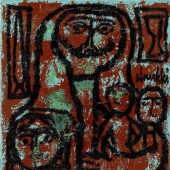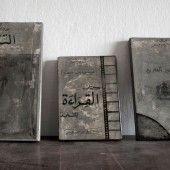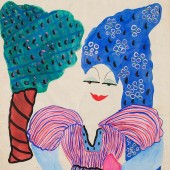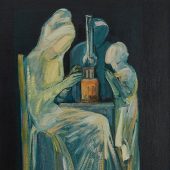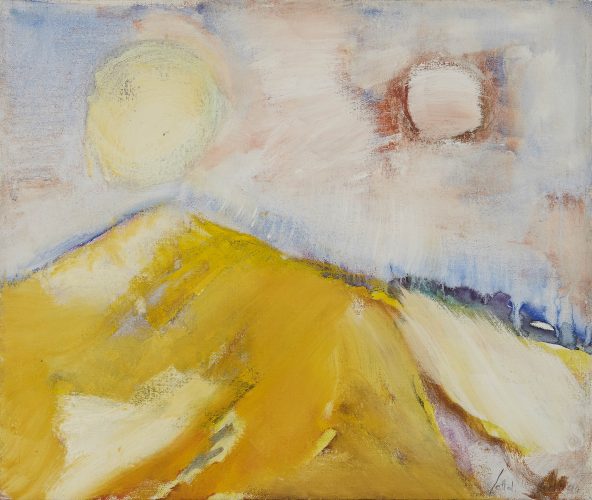
In the painting, La Montagne Liban (Mount Lebanon), partners and artists Etel Adnan and Simone Fattal collaborated to create an otherworldly depiction of Mount Lebanon in saturated yellow. Under what appears to be a sun and a moon, their washed brushstrokes of pastel pink, blue and yellow illustrate a painterly landscape of day and night seemingly collapsing into one another. Produced when the two artists first met, the painting is an ode to their shared experience and mutual affinity with the natural world. A rare collaboration by Adnan, a poet, scholar and painter and Simone, a sculptor, painter and translator, lovingly combines their approaches. While both artists identify themselves as Arab-Americans based on their long residence in the United States, each artist retains an engagement with their native lands: Adnan to Lebanon and Fattal to Syria.
In the early 1970s, Adnan returned to work in Beirut after a 14 year tenure as a philosophy professor in Northern California to work as the cultural editor of two newspapers from 1972 to 1976. Her experience resulted in Sitt Marie Rose, a seminal novel recounting the Lebanese Civil War. Adnan’s figureless abstract and landscape paintings have a clarity of lines and pure tonal colours which resonate with her poetry and existential philosophy. Fattal was also interested in landscape, which is particularly illustrated in her earlier paintings that depict studies of Mount Sannine in Beirut. In her clay work, Fattal’s preoccupation with the non-figurative was an expression of her fascination with history and contemporary culture.
Adnan has received worldwide critical acclaim for her poetry, novels and art holding multiple solo exhibitions that include the Serpentine Gallery (2016), Insitut du Monde Arabe (2016) and a retrospective at the Mathaf: Arab Museum of Modern Art in Doha (2014). Fattal first studied philosophy at the Ecole des Lettres of Beirut and then at the Sorbonne in Paris. Fleeing the Civil War, Fattal settled in California and founded the Post-Apollo Press, a publishing house dedicated to innovative and experimental literary work. In 1988, she returned to artistic practice producing ceramic sculptures after enrolling at the Art Institute of San Francisco. Since 2006, she has produced works in Hans Spinner’s prestigious workshop in Grasse, France.
تعاونت الشريكتان والفنانتان إيتيل عدنان وسيمون فتال في لوحة جبل لبنان لإبداع صورة حالمة لجبل لبنان، وذلك باستخدام اللون الأصفر. وفي أسفل ما يبدو صورة لشمس وقمر، استعملت الفنانتان ضربات الفرشاة بألوان الوردي الفاتح والأزرق والأصفر لإظهار مشهد تصويري يبدو فيه الليل والنهار مندمجان ببعضهما البعض. وتم إنتاج هذه اللوحة عندما التقت الفنانتان ببعضهما للمرة الأولى، حيث كانت بمثابة قصيدة غنائية تجسد تجربتهما المشتركة وعلاقتهما المتبادلة مع الطبيعة. كما تُعدّ هذه اللوحة تعاوناً نادراً بين عدنان؛ الشاعرة والكاتبة والرسامة، وفتال؛ النحاتة والرسامة والمترجِمة، حيث مزجتا نهجهما الفني فيها. وبينما تُعرّف الفنانتان عن نفسيهما بأنهما عربيتان-أمريكيتان بسبب إقامتهما الطويلة في الولايات المتحدة، إلا أن كل منهما تحتفظ بانتمائها إلى بلدها الأم: حيث تنتمي عدنان إلى لبنان وفتال إلى سوريا.
في أوائل السبعينيات عادت عدنان إلى بيروت بعد فترة غياب دامت 14 سنة، حيث كانت أستاذة في الفلسفة في شمال كاليفورنيا ثم انتقلت إلى لبنان لتعمل محررة ثقافية في جريدتين بين عامي 1972 و1976. وأثمرت تجربتها هذه عن رواية “الست ماري روز” المؤثرة التي تتحدث عن الحرب الأهلية اللبنانية. تتميز لوحات عدنان التجريدية والخالية من الأشكال والتي تصور المشهد الطبيعي، بوضوح الخطوط والتدرجات اللونية النقية، والتي تتناغم مع شعرها وفلسفتها الوجودية. بينما اهتمت فتال بالمشهد الطبيعي في لوحاتها، ويبدو ذلك جلياً في لوحاتها الأولى التي تصور دراساتٍ عن جبل صنين في بيروت. كما يتجلى انشغال فتال باللارمزية في أعمالها الفخارية كتعبير عن شغفها بالتاريخ والثقافة المعاصرة.
حظيت الفنانة عدنان بإشادة واسعة من النقاد من جميع أنحاء العالم سواء لشعرها أو رواياتها أو لوحاتها الفنية، حيث أقيمت لها معارض منفردة في معرض سربنتين (عام 2016) ومعهد العالم العربي بباريس (عام 2016) ومعرضاً استعادياً في متحف: المتحف العربي للفن الحديث بالدوحة (عام 2014). بينما درست فتال أولاً الفلسفة في كلية الآداب ببيروت ثم في جامعة السوربون بباريس. وهربت من الحرب الأهلية اللبنانية لتستقر في كاليفورنيا حيث أسّست دار نشر “بوست أبولو بريس” للأعمال الأدبية التجريبية والإبداعية. وعادت في عام 1988 إلى الفن بإنتاجها منحوتات خزفية، وذلك بعد التحاقها بمعهد الفنون في سان فرانسيسكو. وما تزال تنتج أعمالها منذ عام 2006 في ورشة هانس سبينر المرموقة في مدينة غراس بفرنسا.




